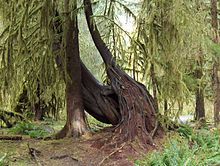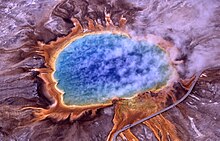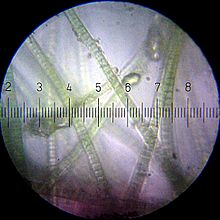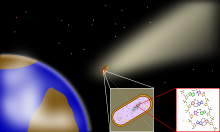Living organisms undergo
metabolism, maintain
homeostasis, possess a capacity to
grow, respond to
stimuli,
reproduce and, through
natural selection, adapt to their environment in successive generations. More complex living organisms can communicate through various means.
[1][5] A diverse array of living organisms (life forms) can be found in the
biosphere on
Earth, and the properties common to these organisms—
plants,
animals,
fungi,
protists,
archaea, and
bacteria—are a
carbon- and
water-based
cellular form with complex
organizationand heritable
genetic information.
Early theories about life
Materialism

Herds of zebra and impala gathering on the
Maasai Mara plain
Some of the earliest theories of life were
materialist, holding that all that exists is matter, and that all life is merely a complex form or arrangement of matter.
Empedocles (430 BC) argued that every thing in the universe is made up of a combination of
four eternal "elements" or "roots of all": earth, water, air, and fire. All change is explained by the arrangement and rearrangement of these four elements. The various forms of life are caused by an appropriate mixture of elements. For example, growth in plants is explained by the natural downward movement of earth and the natural upward movement of fire.
[6]Democritus (460 BC), the disciple of
Leucippus, thought that the essential characteristic of life is having a soul (
psyche). In common with other ancient writers, he used the term to mean the principle of living things that causes them to function as a living thing. He thought the soul was composed of fire atoms, because of the apparent connection between life and heat, and because fire moves.
[7] He also suggested that humans originally lived like animals, gradually developing communities to help one another, originating language, and developing crafts and agriculture.
[8] Hylomorphism
Hylomorphism is the theory (originating with
Aristotle (322 BC)) that all things are a combination of matter and form. Aristotle was one of the first ancient writers to approach the subject of life in a scientific way. Biology was one of his main interests, and there is extensive biological material in his extant writings. According to him, all things in the material universe have both matter and form. The form of a living thing is its
soul (Greek
psyche, Latin
anima). There are three kinds of souls: the "vegetative soul" of plants, which causes them to grow and decay and nourish themselves, but does not cause motion and sensation; the "animal soul" which causes animals to move and feel; and the rational soul which is the source of consciousness and reasoning which (Aristotle believed) is found only in man.
[9] Each higher soul has all the attributes of the lower one. Aristotle believed that while matter can exist without form, form cannot exist without matter, and therefore the soul cannot exist without the body.
[10] Consistent with this account is a
teleological explanation of life. A teleological explanation accounts for phenomena in terms of their purpose or goal-directedness. Thus, the whiteness of the polar bear's coat is explained by its
purpose of camouflage. The direction of causality is the other way round from materialistic science, which explains the consequence in terms of a prior cause. Modern biologists now reject this functional view in terms of a material and causal one: biological features are to be explained not by looking
forward to future optimal results, but by looking
backwards to the past evolutionary history of a species, which led to the
natural selection of the features in question.
Vitalism
Vitalism underpinned the idea of a fundamental separation of organic and inorganic material, and the belief that organic material can only be derived from living things. This was disproved in 1828 when
Friedrich Wöhler prepared urea from inorganic materials.
[11] This so-called
Wöhler synthesis is considered the starting point of modern
organic chemistry. It is of historical significance because for the first time an
organic compound was produced from
inorganicreactants.
Later,
Helmholtz, anticipated by
Mayer, demonstrated that no energy is lost in muscle movement, suggesting that there were no
vital forces necessary to move a muscle. These empirical results led to the abandonment of scientific interest in vitalistic theories, although the belief lingered on in non-scientific theories such as
homeopathy, which interprets diseases and sickness as caused by disturbances in a hypothetical vital force or life force.
Definitions
It is still a challenge for scientists and philosophers to define life in unequivocal terms.
[12][13][14] Defining life is difficult—in part—because life is a process, not a pure substance.
[15] Any definition must be sufficiently broad to encompass all life with which we are familiar, and it should be sufficiently general that, with it, scientists would not miss life that may be fundamentally different from life on Earth.
[16]Biology
Since there is no unequivocal definition of life, the current understanding is descriptive, where life is a characteristic of organisms that exhibit all or most of the following
phenomena:
[15][17]- Homeostasis: Regulation of the internal environment to maintain a constant state; for example, electrolyte concentration or sweating to reduce temperature.
- Organization: Being structurally composed of one or more cells, which are the basic units of life.
- Metabolism: Transformation of energy by converting chemicals and energy into cellular components (anabolism) and decomposing organic matter (catabolism). Living things require energy to maintain internal organization (homeostasis) and to produce the other phenomena associated with life.
- Growth: Maintenance of a higher rate of anabolism than catabolism. A growing organism increases in size in all of its parts, rather than simply accumulating matter.
- Adaptation: The ability to change over a period of time in response to the environment. This ability is fundamental to the process of evolution and is determined by the organism'sheredity as well as the composition of metabolized substances, and external factors present.
- Response to stimuli: A response can take many forms, from the contraction of a unicellular organism to external chemicals, to complex reactions involving all the senses of multicellular organisms. A response is often expressed by motion, for example, the leaves of a plant turning toward the sun (phototropism) and by chemotaxis.
- Reproduction: The ability to produce new individual organisms, either asexually from a single parent organism, or sexually from two parent organisms.
Proposed
To reflect the minimum phenomena required, some have proposed other biological definitions of life:
- A network of inferior negative feedbacks (regulatory mechanisms) subordinated to a superior positive feedback (potential of expansion, reproduction).[18]
- A systemic definition of life is that living things are self-organizing and autopoietic (self-producing). Variations of this definition include Stuart Kauffman's definition as an autonomous agent or a multi-agent system capable of reproducing itself or themselves, and of completing at least one thermodynamic work cycle.[19]
- Living beings are thermodynamic systems that have an organized molecular structure.[20]
- Things with the capacity for metabolism and motion.[15]
- Life is a delay of the spontaneous diffusion or dispersion of the internal energy of the biomolecules towards more potential microstates.[20]
- Life is a self-sustained chemical system capable of undergoing Darwinian evolution.[21]
- Life is matter that can reproduce itself and evolve as survival dictates.[22][23]
Viruses
Viruses are most often considered
replicators rather than forms of life. They have been described as "organisms at the edge of life,"
[24] since they possess
genes,
evolve by
natural selection,
[25] and replicate by creating multiple copies of themselves through self-assembly. However, viruses do not
metabolize and require a host cell to make new products. Virus self-assembly within host cells has implications for the study of the
origin of life, as it may support the hypothesis that life could have started as self-assembling organic molecules.
[26][27] Biophysics
Living systems theories
Some scientists have proposed in the last few decades that a general
living systems theory is required to explain the nature of life.
[33] Such a general theory, arising out of the
ecologicaland
biological sciences, attempts to map general principles for how all living systems work. Instead of examining phenomena by attempting to break things down into component parts, a general living systems theory explores phenomena in terms of dynamic patterns of the relationships of organisms with their environment.
[34]Gaia hypothesis
The idea that the Earth is alive is probably as old as humankind, but the first public expression of it as a fact of science was by a Scottish scientist,
James Hutton. In 1785 he stated that the Earth was a superorganism and that its proper study should be
physiology. Hutton is rightly remembered as the father of geology, but his idea of a living Earth was forgotten in the intense reductionism of the 19th century.
[35] The
Gaia hypothesis, originally proposed in the 1960s by scientist
James Lovelock,
[36][37] explores the idea that the life on Earth functions as a single organism which actually defines and maintains environmental conditions necessary for its survival.
[38]Nonfractionability
Robert Rosen (1991) built on the assumption that the explanatory powers of the mechanistic worldview cannot help understand the realm of living systems. One of several important clarifications he made was to define a system component as "a unit of organization; a part with a function, i.e., a definite relation between part and whole." From this and other starting concepts, he developed a "relational theory of systems" that attempts to explain the special properties of life. Specifically, he identified the "nonfractionability of components in an organism" as the fundamental difference between living systems and "biological machines."
[39] Life as a property of ecosystems
A systems view of life treats environmental
fluxes and biological fluxes together as a "reciprocity of influence",
[40] and a reciprocal relation with environment is arguably as important for understanding life as it is for understanding ecosystems. As Harold J. Morowitz (1992) explains it, life is a property of an
ecological system rather than a single organism or species.
[41]He argues that an ecosystemic definition of life is preferable to a strictly biochemical or physical one.
Robert Ulanowicz (2009) also highlights mutualism as the key to understand the systemic, order-generating behavior of life and ecosystems.
[42]Origin
Main article:
Origin of lifeFor religious beliefs about the creation of life, see
Creation myth.
Evidence suggests that
life on Earth has existed for about 3.7
billion years,
[43] with the oldest traces of life found in fossils dating back 3.4 billion years.
[44] All known life forms share fundamental molecular mechanisms, and based on these observations, theories on the origin of life attempt to find a mechanism explaining the formation of a primordial single cell organism from which all life originates. There are many different hypotheses regarding the path that might have been taken from simple
organic molecules via pre-cellular life to protocells and metabolism. Many models fall into the "
genes-first" category or the "
metabolism-first" category, but a recent trend is the emergence of hybrid models that combine both categories.
[45]There is no scientific consensus as to how life originated and all proposed theories are highly speculative. However, most currently accepted scientific models build in one way or another on the following hypotheses:
Life as we know it today synthesizes
proteins, which are
polymers of amino acids using instructions encoded by cellular
genes—which are polymers of
deoxyribonucleic acid (DNA).
Protein synthesis also entails intermediary
ribonucleic acid (RNA) polymers. One possibility is that genes came first
[46] and then proteins. Another possibility is that proteins came first
[47] and then genes. However, because genes are required to make proteins, and proteins are required to make genes, the problem of considering which came first is like that of the
chicken or the egg. Most scientists have adopted the hypothesis that because DNA and proteins function together so intimately, it's unlikely that they arose independently.
[48] Therefore, many scientists consider the possibility, apparently first suggested by
Francis Crick,
[49] that the first life was based on the DNA-protein intermediary:
RNA.
[48] In fact, RNA has the DNA-like properties of information storage and replication and the
catalytic properties of some proteins. Crick and others actually favored the
RNA-first hypothesis[50] even before the catalytic properties of RNA had been demonstrated by
Thomas Cech.
[51]A significant issue with the RNA-first hypothesis is that experiments designed to synthesize RNA from simple precursors have not been nearly as successful as the Miller-Urey experiments that synthesized other organic molecules from inorganic precursors. One reason for the failure to create RNA in the laboratory is that RNA precursors are very stable and do not react with each other under ambient conditions. However, the successful synthesis of certain RNA molecules under conditions hypothesized to exist prior to life on Earth has been achieved by adding alternative precursors in a specified order with the precursor
phosphate present throughout the reaction.
[52] This study makes the RNA-first hypothesis more plausible to many scientists.
[53]Recent experiments have demonstrated true
Darwinian evolution of unique RNA enzymes (
ribozymes) made up of two separate catalytic components that replicate each other
in vitro.
[54]In describing this work from his laboratory,
Gerald Joyce stated: "This is the first example, outside of biology, of evolutionary adaptation in a molecular genetic system."
[55] Such experiments make the possibility of a primordial
RNA World even more attractive to many scientists.
Conditions for life
The diversity of life on Earth today is a result of the dynamic interplay between
genetic opportunity, metabolic capability,
environmentalchallenges,
[60] and
symbiosis.
[61][62][63] For most of its existence, Earth's habitable environment has been dominated by
microorganisms and subjected to their
metabolism and
evolution. As a consequence of such microbial activities on a
geologic time scale, the physical-chemical environment on Earth has been changing, thereby determining the path of evolution of subsequent life.
[60] For example, the release of molecular
oxygen by
cyanobacteria as a by-product of
photosynthesis induced fundamental, global changes in the Earth's environment. The altered environment, in turn, posed novel evolutionary challenges to the organisms present, which ultimately resulted in the formation of our planet's major animal and plant species. Therefore this "co-evolution" between organisms and their environment is apparently an inherent feature of living systems.
[60]Range of tolerance
The inert components of an
ecosystem are the physical and chemical factors necessary for life—energy (
sunlight or
chemical energy),
water,
temperature,
atmosphere,
gravity,
nutrients, and
ultraviolet solar radiation protection.
[64] In most ecosystems the conditions vary during the day and often shift from one
season to the next. To live in most ecosystems, then, organisms must be able to survive a range of conditions, called "range of tolerance."
[65] Outside of that are the "zones of physiological stress," where the survival and reproduction are possible but not optimal. Outside of these zones are the "zones of intolerance," where life for that organism is implausible. It has been determined that organisms that have a wide range of tolerance are more widely distributed than organisms with a narrow range of tolerance.
[65]Extremophiles
Main article:
ExtremophileTo survive, some microorganisms can assume forms that enable them to withstand
freezing,
complete desiccation,
starvation, high-levels of
radiation exposure, and other physical or chemical challenges. Furthermore, some microorganisms can survive exposure to such conditions for weeks, months, years, or even centuries.
[60] Extremophiles are microbial life forms that thrive outside the ranges life is commonly found in. They also excel at exploiting uncommon sources of energy. While all organisms are composed of nearly identical
molecules, evolution has enabled such microbes to cope with this wide range of physical and chemical conditions. Characterization of the
structure and metabolic diversity of microbial communities in such
extreme environments is ongoing. An understanding of the tenacity and versatility of life on Earth, as well as an understanding of the molecular systems that some organisms utilize to survive such extremes, will provide a critical foundation for the search for
life beyond Earth.
[60]Chemical element requirements
Classification of life
Traditionally, people have divided organisms into the classes of
plants and
animals, based mainly on their ability of movement. The first known attempt to classify organisms was conducted by the Greek philosopher
Aristotle (384–322 BC). He classified all living organisms known at that time as either a plant or an animal. Aristotle distinguished animals with blood from animals without blood (or at least without red blood), which can be compared with the concepts of
vertebrates and
invertebrates respectively. He divided the blooded animals into five groups: viviparous quadrupeds (
mammals),
birds, oviparous quadrupeds (
reptiles and
amphibians),
fishes and
whales. The bloodless animals were also divided into five groups:
cephalopods,
crustaceans, insects (which also included the
spiders,
scorpions, and
centipedes, in addition to what we now define as
insects), shelled animals (such as most
molluscs and
echinoderms) and "
zoophytes." Though Aristotle's work in zoology was not without errors, it was the grandest biological synthesis of the time and remained the ultimate authority for many centuries after his death.
[67]The exploration of the
American continent revealed large numbers of new plants and animals that needed descriptions and classification. In the latter part of the 16th century and the beginning of the 17th, careful study of animals commenced and was gradually extended until it formed a sufficient body of knowledge to serve as an anatomical basis for classification.
In the late 1740s,
Carolus Linnaeus introduced his method, still used, to formulate the
scientific name of every species.
[68] Linnaeus took every effort to improve the composition and reduce the length of the many-worded names by abolishing unnecessary rhetoric, introducing new descriptive terms and defining their meaning with an unprecedented precision. By consistently using his system, Linnaeus separated
nomenclature from
taxonomy. This convention for naming species is referred to as
binomial nomenclature.
The
fungi were originally treated as plants. For a short period Linnaeus had placed them in the taxon
Vermes in Animalia. He later placed them back in Plantae.
Copeland classified the Fungi in his Protoctista, thus partially avoiding the problem but acknowledged their special status.
[69] The problem was eventually solved by
Whittaker, when he gave them their own kingdom in his
five-kingdom system. As it turned out, the fungi are more closely related to animals than to plants.
[70]As
microbiology,
molecular biology and
virology developed, non-cellular reproducing agents were discovered, such as
viruses and
viroids. Sometimes these entities are considered to be alive but others argue that viruses are not living organisms since they lack characteristics such as
cell membrane,
metabolism and do not grow or respond to their environments. Viruses can however be classed into "species" based on their biology and genetics but many aspects of such a classification remain controversial.
[73]
Earth is the only planet in the universe known to harbor life. The
Drake equation, which relates the number of extraterrestrial civilizations in our galaxy with which we might come in contact, has been used to discuss the probability of life elsewhere, but scientists disagree on many of the values of variables in this equation. Depending on those values, the equation may either suggest that life arises frequently or infrequently.
The region around a
main sequence star that could support Earth-like life on an Earth-like planet is known as the
habitable zone. The inner and outer radii of this zone vary with the luminosity of the star, as does the time interval during which the zone will survive. Stars more massive than the Sun have a larger habitable zone, but will remain on the main sequence for a shorter time interval during which life can evolve. Small
red dwarf stars have the opposite problem, compounded with higher levels of
magnetic activity and the effects of tidal locking from close orbits. Hence, stars in the intermediate mass range such as the Sun may possess the optimal conditions for Earth-like life to develop. The location of the star within a galaxy may also have an impact on the likelihood of life forming.
Panspermia, also called exogenesis, is a
hypothesis proposing that life originated elsewhere in the universe and was subsequently transferred to Earth in the form of
spores perhaps via
meteorites,
comets or
cosmic dust. However, this hypothesis does not help explain the ultimate origin of life.
Death
One of the challenges in defining death is in distinguishing it from life. Death would seem to refer to either the moment at which life ends, or when the state that follows life begins.
[86]However, determining when death has occurred requires drawing precise conceptual boundaries between life and death. This is problematic, however, because there is little consensus over how to define life. The nature of death has for millennia been a central concern of the world's religious traditions and of philosophical inquiry. Many religions maintain faith in either some kind of
afterlife,
reincarnation, or
resurrection.
Extinction
Extinction is the gradual process by which a group of
taxa or
species dies out, reducing
biodiversity.
[87] The moment of extinction is generally considered to be the death of the last individual of that species. Because a species' potential
range may be very large, determining this moment is difficult, and is usually done retrospectively after a period of apparent absence. Species become extinct when they are no longer able to survive in changing
habitat or against superior competition. Over the history of the Earth, over 99% of all the species that have ever lived have gone extinct;
[88] however,
mass extinctions may have accelerated
evolution by providing opportunities for new groups of organisms to diversify.
[89] Fossils
Fossils are the preserved remains or
traces of animals, plants, and other organisms from the remote past. The totality of fossils, both discovered and undiscovered, and their placement in fossil-containing
rock formations and
sedimentary layers (
strata) is known as the
fossil record. Such a preserved specimen is called a "fossil" if it is older than the arbitrary date of 10,000 years ago.
[90] Hence, fossils range in age from the youngest at the start of the
Holocene Epoch to the oldest from the
Archaean Eon, up to 3.4
billion years old.
[91][92]
.jpg) Visiting Sri Lanka…
Visiting Sri Lanka…





 අලව්ව දුම්රිය ස්ථානයේදී පෙරේදා (17 වැනිදා) පස්වරුවේ දුම්රිය දෙකක් එකිනෙක ගැටී සිදු වූ මාරක අනතුරට හේතුව දුම්රිය පාලක මැදිරියේ හා සංඥා පද්ධතියේ ඇති වූ ප්රමාද දෝෂයක් බවට සැක මතු වී තිබේ.
අලව්ව දුම්රිය ස්ථානයේදී පෙරේදා (17 වැනිදා) පස්වරුවේ දුම්රිය දෙකක් එකිනෙක ගැටී සිදු වූ මාරක අනතුරට හේතුව දුම්රිය පාලක මැදිරියේ හා සංඥා පද්ධතියේ ඇති වූ ප්රමාද දෝෂයක් බවට සැක මතු වී තිබේ.











